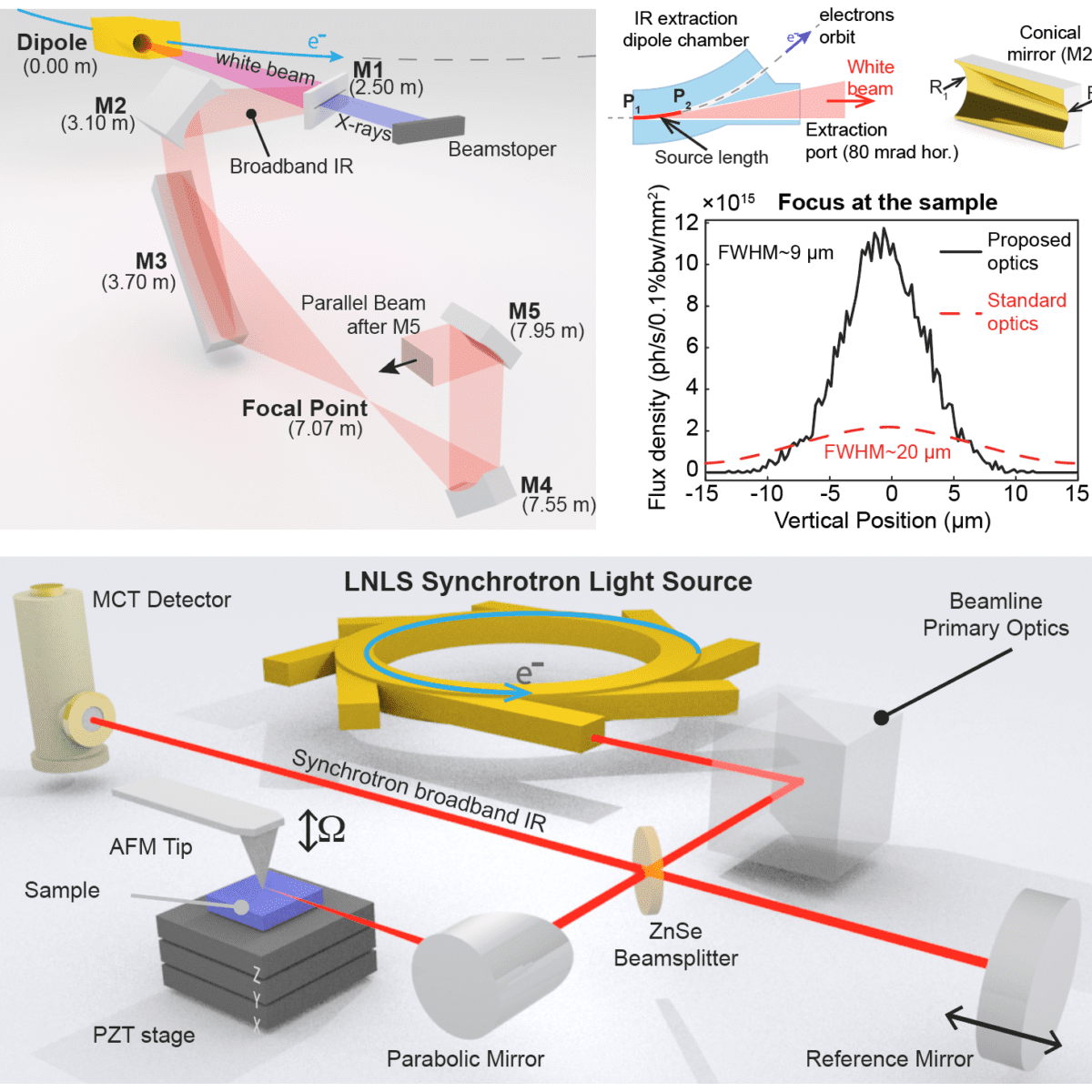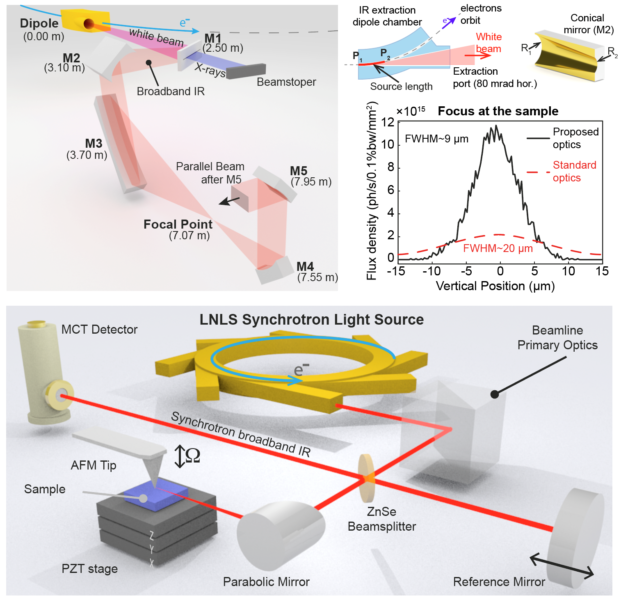
First experimental report of a special optical layout dedicated to correct typical aberrations derived from large extraction ports in IR beamlines
Infrared nanospectroscopy represents a major breakthrough in chemical analysis since it allows the identification of nanomaterials via their natural (label free) vibrational signatures. Classically powered by laser sources, the experiment called scattering Scanning Near-field Optical Microscopy (s-SNOM) has become a standard tool for investigations of chemical and optical properties of materials beyond the diffraction limit of light.
Lately, s-SNOM is achieving unprecedent sensitivity range by exploring the outstanding spectral irradiance of synchrotron light sources in the full range of infrared (IR) radiation. In the last few years, the combination of s-SNOM and ultra-broadband IR synchrotron (SINS or nano-FTIR) has helped studies in relevant scientific fronts involving atomic layered materials, fundamental optics, nanostructured bio-materials and, very recently, it was demonstrated to be feasible to work in the far-IR.
IR ports in synchrotron storage rings can be up to a thousand times more brilliant than classical IR black body sources. This advantage allowed IR beamlines to be the only places capable of performing IR micro-spectroscopy for many years. However, in comparison to X-ray ports, IR beamlines require large apertures for allowing long wavelengths to be extracted. Consequently, IR beamlines typically present optical aberrations such as extended source depth and coma.
For the nano-FTIR experiment, the IR synchrotron beam must be focused on a shaft of an atomic force microscope (AFM), which requires ultra-high IR flux density at the focal spot. Hence, a sharp focal point is essential for reaching an optimal signal-to-noise ratio (SNR) in the nano-FTIR experiment.
In a paper published in the journal Optics Express, researchers from the Brazilian Synchrotron Light Laboratory (LNLS) and collaborators from the SOLEIL synchrotron reported the use of a special optical layout dedicated to correct typical aberrations derived from large extraction ports in IR beamlines. Despite being previously proposed as an optical concept, this is the first experimental report of this optical layout operating in a beamline. With this low-aberration beamline optics, the team tested the sensitivity limits of the nano-FTIR experiment, which was able to identify C=O bonds in a 6 nm thick polymer film. The work presents details of the optical components, IR beam characterization and performance figures that are now available for the community.

Figure 1 – Proposed optical layout, IR extraction chamber indicating the source depth, conical mirror illustration, aberration-corrected focal spot at the sample stage and nano-FTIR experimental scheme in operation in the IR endstation of the LNLS. Figure adapted from R. Freitas et al., Optics Express 26, 11238 (2018).
The LNLS team expects that this new report will provide a template for future IR beamlines aiming at experiments that require low-aberration beams.
The IR1 nano-FTIR endstation is currently operating in LNLS’ 2nd generation accelerator. This endstation will soon be transferred to SIRIUS, the new Brazilian 4th generation synchrotron light source, where it will integrate the IMBUIA beamline: a set of IR endstations dedicated to multiscale IR analysis. Set to enter commissioning in the second semester of 2019, IMBUIA aims at mid and far-IR spectroscopy with unprecedent vibrational sensitivity provided by SIRIUS higher brilliance and exceptional stability levels in the IR range.
Source: Raul O. Freitas, Christoph Deneke, Francisco C. B. Maia, Helton G. Medeiros, Thierry Moreno, Paul Dumas, Yves Petroff and Harry Westfahl, Low-aberration beamline optics for synchrotron infrared nanospectroscopy, Optics Express 26 (9), 11238 (2018). DOI: 10.1364/OE.26.011238
New thermoelectric material shows great potential for wearable devices, embedded to clothing and accessories, and other flexible technologies
Research investigates the control of electric polarization in ferroelectric ceramics by the incidence of light